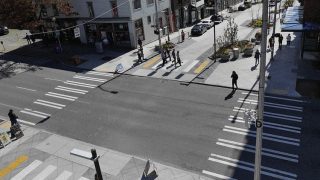
(Rendering of Bell Street in Seattle, a model
for Chicago’s project, by SvR Design Company)
Here are the great bike-related links from around the world that caught our eyes this week:
Shared street: Early next year, four blocks of Chicago’s Argyle Street will be rebuilt in a “radical experiment” with no sidewalks, crosswalks, curbs, lane markings, or signals and almost no signs.
The birth of ‘cross: Could this French biking newsletter from 1901 have the report of the very first cyclocross race?
Detection indicators: “Perhaps because so much infrastructure is so indifferent to bicycles, discovering a piece that responds to your presence feels a bit like having the bronze statue in a memorial open its eyes and greet you by name,” writes Carl Alviani about the little blue lights, now at nine local intersections, that are Portland’s latest contribution to biking.
Visible victims: A national review of 90 New Zealand biking fatalities concluded that in more cases than not, at-fault drivers could have seen the bikes. They just weren’t looking for them.
Crowdfunded cycle track: Downtown Denver’s business association is setting out to crowdfund $35,000 for a protected bike lane. A major oil company is among seven corporations that have already pledged to chip in.
Against death: After a New Yorker writer makes the case for driving through his city at lethal speeds, Brooklyn Spoke offers a definitive rebuttal.
Small-town density: The Federal Reserve Bank of St. Louis explores whether population density is as good for the economies of small towns as it is for those of cities.
Advertisement
Ebola panic cure: If the state of Maine is ordering you to stay in your house for what you are certain is no reason, a fall bike ride with your boyfriend seems like a pretty good way to relax.
The king of bikes: If you are the former king of Bhutan, who refocused your country’s economy on maximizing happiness and then voluntarily ended your country’s absolute monarchy, biking can also be rewarding. The country has followed his example, leading to a high-altitude bike movement.
Tech support: “We look forward to using the protected routes to help us attract and retain the people we need to continue to thrive,” writes Microsoft UK in its letter of support for London’s proposed “Cycle Superhighways.”
Nice rides: Trips on Minneapolis’s five-year-old bike sharing system rose 33 percent in 2014. It now has a fleet of 1,500 bikes.
Citi Bike growth: The sale of Alta Bicycle Share supposedly heralds not only a 50 percent price hike but a massive expansion into a four-borough, 12,000-bike service by 2017.
Bike sharing equity: Matt Yglesias speculates that few poor Americans use bike sharing systems (true) because most poor people who can bike to work already do (um…).
Car ads move on: The New York Times is killing its dedicated autos section, saying the advertising demand has gone.
Pictures of success: You know, that fellow Banksy knows a good image (by Andy Singer) when he sees one:
successful pic.twitter.com/D3aW0VgQpK
— banksy (@thereaIbanksy) October 30, 2014
Glowing bike lanes: As phosphorescent bike lanes are being installed in the Netherlands, the company that created them is going global.
And finally, I definitely saw some people I know, spreading the gospel of bike moves to Italy, in the first segment of your video of the week:
If you come across a noteworthy bicycle story, send it in via email, Tweet @bikeportland, or whatever else and we’ll consider adding it to next Monday’s roundup.

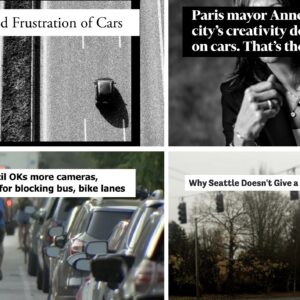
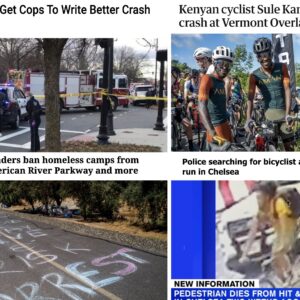
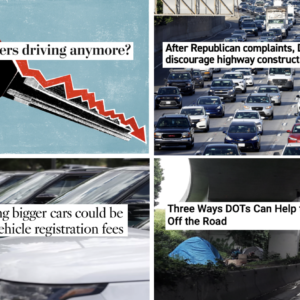
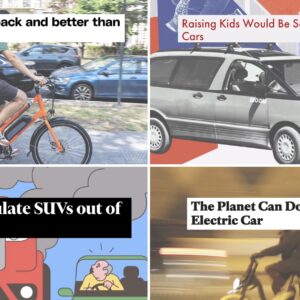
Thanks for reading.
BikePortland has served this community with independent community journalism since 2005. We rely on subscriptions from readers like you to survive. Your financial support is vital in keeping this valuable resource alive and well.
Please subscribe today to strengthen and expand our work.
About that ‘radical experiment in Chicago:
“We’re not going to encourage jaywalking, but that may happen,”
I think the person may not understand the concept. That is exactly the kind of hierarchical thinking I assumed this effort was meant to transcend.
Who’s Banksy?
That’s an Andy Singer cartoon.
He’s just sharing it. I don’t think he’s taking credit.
He fooled me, though. I’ve revised to make this clear.
Yeah I had the same reaction. It’s a shame that Andy Singer’s name isn’t on that cartoon or in the tweet, it’d be nice to see him get the credit. Not that Banksy seems to be taking credit, but it’s obviously easy to assume it’s his.
Here a good use of Singer’s work, which I believe was commissioned for this PPS article:
http://www.pps.org/reference/levels-of-service-and-travel-projections-the-wrong-tools-for-planning-our-streets/
Whos Banksy? Hahahaha, good one!
Glad you thought it funny. I’ve never heard of it/him.
See, thats the joke: he is the most famous anonymous artist in the world.
funny.
http://en.wikipedia.org/wiki/Exit_Through_the_Gift_Shop
The article on the little blue lights is really well written and makes its points exceptionally well. I hope to start seeing little blue lights all over town.
Thanks Jonathan! It’s always a little unnerving to do an article on something this wonky and esoteric, so it’s nice to know other people found it interesting too. Any suggestions for future infrastructure components to cover?
Agreed. A must read. Well done PBOT and Peter Koonce.
The New Zealand story: wsbob, take note!
“Rather than ‘not seeing’ (as is often cited), more often than not this would appear to be more a case of ‘not looking’.”
“motorists are far too often responsible for these crashes. This points towards greater efforts in driver education and enforcement,
and possibly legislation that places greater responsibility on drivers.”
“helmets are generally no protection to the serious forces involved in a major motor vehicle crash; they are only designed for falls.”
An excellently framed and tidy report, by the way.
Haven’t read the item in today’s roundup, but have read others from from New Zealand and Australia about bike helmets use. Some people in those countries, as elsewhere, persistently try to get other people to ignore the reality that a fall from a bike, generally, basically what happens in collisions between bikes and motor vehicles. Protection against consequences of falling is where bike helmets can be helpful.
Attempting to shift responsibility for safe road use all people biking should practice, onto people driving, is another common ploy.
This shifting responsibility onto others trope is your new thing, apparently.
Where does it come from, wsbob? Please explain, give examples.
Nothing new. You should know well enough from your past efforts to try sell the idea that the safety of vulnerable road users should be completely borne by people driving. Good luck.
“should be completely borne by people driving”
wait, who said that? I didn’t. The New Zealand report didn’t. Let’s stick with what we have before us, shall we?
My complaint is and has for years here been with campaigns, or in your case statements, that focus attention on behaviors or dress people walking and biking are to adopt, without acknowledging that *most* of the responsibility to not kill or maim anyone lies/should lie with those driving around in their cars. That additional efforts we might wish to persuade people to take should not fall disproportionately on the so-called vulnerable road users, simply because they are not the ones causing any harm to either themselves or others, but rather find themselves in the category of crash victims that is currently on the rise.
As we’ve had plenty of occasion to discuss, most everyone (blind people, children, wildlife excepted) can and should be expected to do a few sensible things to reduce their chances of getting creamed by someone in a car (have lights on their bikes at night, keep their wits about them, etc.), but beyond that, it is up to those in those cars to avoid smashing into anyone or anything. Very simple and, one would think, easy to grasp.
Where I’m confused is in your increasingly frequent use of this phrase ‘Attempting to shift responsibility for safe road use all people biking should practice, onto people driving’ as if this were rampant, a problem, somehow itself implicated in the dangerous conditions on our streets. The image this phrase and the glimpses you’ve offered of what you mean by it evoke is of a taunting crowd of drunks gleefully playing chicken with the auto-bound, secure in the knowledge that their evasion of responsibility is going to turn the tables on those responsible souls in cars; cause them to plunge to their deaths in their attempts to evade the irresponsible ones. Since you refuse to offer examples of what you have in mind I’m left to speculate. It still strikes me as fanciful but perhaps you will deign to share your reasoning?
Uh-oh, wsbob. You’re in trouble now!
I should have kept reading that research report from New Zealand:
“Clearly bright clothing did not guarantee a safer outcome; many motorists did not notice the cyclist prior to the crash even when they were wearing reflective or bright colours. In fact the proportion of drivers not noticing a cyclist prior to a crash was not significantly different regardless of whether they were wearing high-visibility (“hi-vis”) clothing or not (Chi-square test, p=0.505). This mirrors research elsewhere, which has generally been inconclusive as to the effects of hi-vis clothing on rider conspicuity (e.g. Wood et al 2009, Washington et al 2011).”
And they continue:
“There is also a real fear that, with a mandatory requirement, the absence of hi-vis gear would be seen as a major contributor to a crash, irrespective of the circumstances of the case, which has implications for Police charges or insurance.”
It’s people as vulnerable road users choosing not to take advantage of simple, easy to afford means by which to enhance their visibility to people driving motor vehicles that are unnecessarily opening themselves to danger.
come again?
It would be worth changing the post to reflect that Andy Singer, not Banksy, made that cartoon.
In fact, that version seems to be purposefully edited to remove his signature. &b=61&ni=224&no=68&ts=&tab=organic&sigr=11f6086bl&sigb=167k2iafo&sigi=12dfj5f50&sigt=114d5e8eq&sign=114d5e8eq&.crumb=bO1XNc4QL7k&fr=yhs-avast-001&fr2=sb-top-images.search.yahoo.com&hsimp=yhs-001&hspart=avast
&b=61&ni=224&no=68&ts=&tab=organic&sigr=11f6086bl&sigb=167k2iafo&sigi=12dfj5f50&sigt=114d5e8eq&sign=114d5e8eq&.crumb=bO1XNc4QL7k&fr=yhs-avast-001&fr2=sb-top-images.search.yahoo.com&hsimp=yhs-001&hspart=avast
I agree. Done, and thanks.
I think the crowdfunding is a great idea. Maybe the people who complain “bikes don’t pay their way” will finally shut up. But then again, they may start thinking that’s how all bike infrastructure should be paid for? I’m not so sure about the crowd funding thing now?
tolls
One of the biggest assets bikes have is the tremendous passion people have for them, look at us all on here spending our free time thinking and commenting about them. Imagine if we could direct our time, money and energy into just going out and actually physically building bike lanes as volunteers some weekend (a la Better Block PDX, Depave, City Repair Project, etc.). Most bike projects really don’t require so much skill, time or money to build yet are bogged down in endless worthless bureaucracy, there is no good reason it needs to take millions of dollars and years to plan, design and build a simple protected bike lane. Obviously it doesn’t work this way and has to go through experts and layers of bureaucracy. But seriously it should be a weekend project for a handful of passionate community minded bike loving people much as they do for a Depave or Intersection Repair event. I just cant get over all the man hours of advocates going to public meetings to speak up for bike projects that vastly outnumber the actual number of hours it would take to just build the dam* thing! That’s the success of all these various tactical urbanism projects across the country.
It’s tough to go build a bike lane on a weekend, but there are lots of goat paths that could use some TLC. Pea gravel to fill a mud hole, for example. Naito has one most of the way from the Fremont Bridge to Hawthorne, including along the Esplanade downtown. You know they get use because, well, they are there.
A semi-diverter island runs about $8,000. A narrow median barrier, like at Harrison/20th or Going/15th, costs about $40/ft, while the wider kind, like Concord/Rosa Parks runs about $200/ft. Diagonal island diverters cost about $23k (not the Ivy/Rodney kind), while the planter version (N Central/Tyler) might set you back $5k if the city doesn’t already have the planters.
Seems pretty doable as crowd-funded upgrades to streets like Clinton, Ankeny, Tillamook…
The new version of Bell St. in seattle is a great idea – in principle. Unfortunately it remains a major route for sov commuters trying to get to highway onramps as the “Turn Only Except Bus and Bikes” signs on every block intended to divert automobile traffic off Bell are universally ignored, and there is no enforcement. Even if auto traffic took part in this “honor system” suggestion-based version of the rules, it’s still a connecting street for multiple bus routes to get to 3rd avenue and as a result isn’t much better than before it was reworked. The main difference is that now people on foot are confused and tend to wander into crosswalks against the light, being startled by the oncoming traffic because the whole thing looks like a pedestrian mall that they’re inexplicably running buses through.
In other words its a complete failure. I love shared streets as much as anyone here, the problem is this isn’t one as much as the designer of it may want to call it one just because there are no curbs.
if there were enough pedestrians to flood the street, motorists would be forced to look elsewhere
Offtopic, but worth noting since links to CityLab appear here so frequently: is Kriston Capps its designated bike-bait click generator?
I’m not linking or even mentioning titles because they don’t deserve it. I’m just saying it’s something to bear in mind.
Correct. Without more street level businesses and without an absence of major traffic the redesign ended up being a waste of time and resources. It looks a little nicer now anyway.
Don’t get me wrong, it wouldn’t take much to take it the rest of the way. Seattle lacks the political will to do this however, which is why it ended up the way it did in the first place.